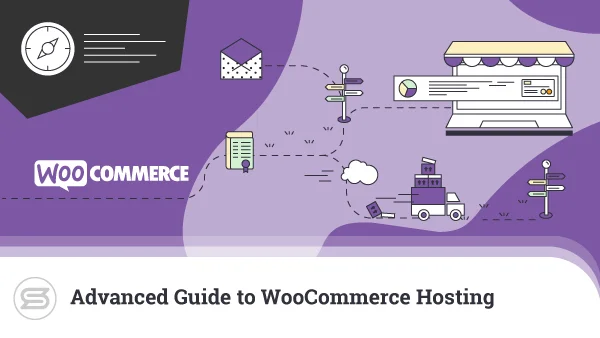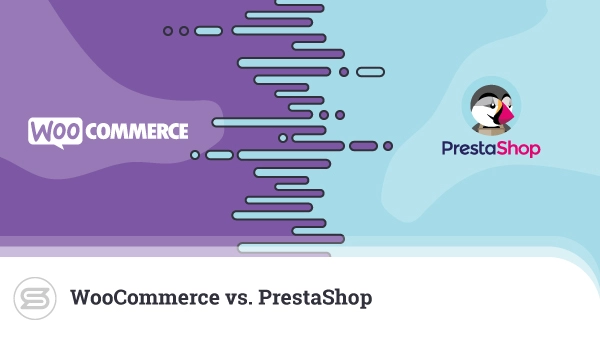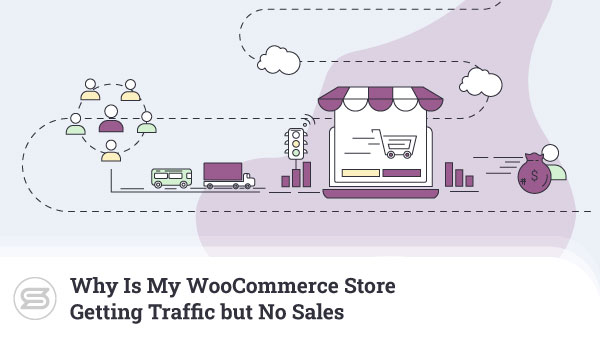In 2019, a whopping 1.9 billion people completed a purchase through an online shop, showcasing just how massive the ecommerce business really is. The sector is growing at break-neck speeds, which is in no small part due to platforms like WooCommerce and Shopify.
Today, we’re going to take a close look at the two industry-leading solutions and help you figure out which of the two is the best option for your online shop. Before we do, however, let’s see how these applications have shaped the ecommerce landscape.
What Is an Ecommerce Platform?
Launching even a small online shop can be an overwhelmingly complex project for beginners. You need good search engine rankings and a design that entices users to buy your products. However, before you start the business, you have to think about securely processing payments, keeping shipping deadlines, issuing invoices, and a ton more essentials.
There’s a lot to consider, and the job of a modern ecommerce platform is to take part of the burden away from you.
Web applications and services like WooCommerce and Shopify give you a hassle-free solution for launching your own ecommerce website. You can create new pages, add categories and products, and set up a payment system without writing a single line of code. Best of all – you can then control the online business through an easy-to-use backend interface.
WooCommerce and Shopify are two of the most popular solutions of this kind, and in essence, they work more or less in the same way. You have a platform that acts as the base for your online shop. Using themes, you can create a unique design, and with the help of add-ons, you can expand the website’s functionality.
As similar as they appear at first, WooCommerce and Shopify belong to two completely different categories of ecommerce platforms.
Types of Ecommerce Platforms
Ecommerce platforms can be split into two distinct categories – hosted and self-hosted.
Hosted ecommerce services like Shopify operate under the Software-as-a-Service (SaaS) model – by far the simpler of the two options. Users register an account and get immediate access to the website building application.
The service provider hosts the ecommerce platform and keeps it online for the duration of the user’s subscription. The main advantage is that everything is pretty much ready from the get-go, and the user doesn’t need to worry about the technical aspects of running a website.
Self-hosted platforms like WooCommerce leave a lot more legwork to the website owner. They need a hosting account to install and configure the application. The domain has to be correctly pointed, and an SSL certificate that protects the user information is also considered essential. Only when they have all this in place can admins start work on the actual website.
Based on this alone, picking between Shopify and WooCommerce sounds like a no-brainer. Starting work on your Shopify website takes no more than a couple of minutes, whereas, with WooCommerce, you have to go through a number of different steps before you can even begin.
Yet, according to BuiltWith, at least 4.4 million live sites use WooCommerce, clearly showing there is a case for it as well.
Let’s go through some of the strengths and weaknesses of the two platforms and see what the reason might be.
WooCommerce Pros & Cons
Pros:
- Free – WooCommerce is completely free and open-source. Just like WordPress, you can download it, install it, and use it without paying a penny.
- Scalability – WooCommerce is not only popular but extremely powerful, as well. According to BuiltWith, nearly 60,000 of the world’s Top 1 Million most visited sites use the plugin, which is a testament to the fact it works well with both small and large projects.
- No special hardware requirements – Any Linux server that can host a WordPress project will happily provide a home to a WooCommerce-based project.
- Helpful open-source community – Ultimately, you’re using WordPress, which means you can utilize the millions of free and premium plugins and themes developed by the global community of fans and professionals. In addition to this, there is a large ecosystem of extensions and templates designed specifically for WooCommerce.
- Run your online shop alongside a company website or blog – Being based on WordPress means that your Woo project can accommodate more than just an online shop. For example, you can build a company website to advertise your business and steer potential customers toward the ecommerce section after they land on your main page.
- More control and customization options – WooCommerce is one of the most customizable self-hosted ecommerce platforms. With it, you have a great chance to create something truly unique without much hassle along the way.
Cons:
- A more difficult initial setup – Compared to Shopify, WooCommerce is a bit more complex to set up. Before you start building your online shop, you’ll need a hosting account with WordPress installed on it. Inexperienced users might also need help setting up the extension itself.
- More responsibilities – You are responsible for a lot more than just finding a suitable hosting provider. You need to configure the application’s backups, plugins, and auto-updates, also having in mind things like security and uptime.


Shopify Pros & Cons
Pros:
- Easier setup – With Shopify, you don’t need to worry about finding a hosting provider or installing and configuring a software platform. You get access to the account as soon as you sign up, and you’re pretty much ready to go from the very start.
- Easier to use – As intuitive as it is, the WordPress dashboard could be a bit confusing for users who have no experience with the CMS. By contrast, Shopify’s backend is designed to be as newbie-friendly as possible.
- Easier customization – Shopify comes with a built-in theme editor, which lets you customize a template through a drag-and-drop interface.
- 24/7 support – Because Shopify is a premium product, you can rely on a dedicated support team to help you out with any technical difficulties.
- A library of apps for extra functionality – The community that supports Shopify may not be as big as the one focused on WordPress and WooCommerce development, but you still get an app store with over 4,000 apps that massively extend the website builder’s functionality.
- Fraud Analysis – Even the cheaper Shopify plans give you a screening system that flags suspicious transactions and reduces the risk of disputes and chargebacks.
Cons:
- Transaction fees – Unless you use Shopify Payments, the platform’s default payment gateway, Shopify will collect transaction fees for every sale you make on your website. Because Shopify Payments works in a limited number of countries, many have no choice but to use a third-party gateway.
- No email hosting – Shopify is focused solely on giving you a platform for your online shop. If you need email inboxes associated with your domain, you’ll need to use a third-party service.
- Fewer themes and customization options – The available themes are not that many, and the options for tailoring the design to your own requirements are somewhat limited.
- Lack of compatibility with other providers – If, for some reason, you are not happy with what Shopify offers, you can’t just take a backup of your website and move it to a different provider. You have to start from scratch.
WooCommerce vs Shopify – a Head-to-Head Comparison
Listing pros and cons alone isn’t going to help you decide which ecommerce platform best suits your project. To do that, you need to examine the two online shop builders in more detail and see how they compare against each other.
Features
Shopify and WooCommerce are equipped with everything you need to set up an online shop. Both give you the ability to sell an unlimited number of physical and digital products. Both have tools for managing prices, discounts, and coupon codes and integrate relatively seamlessly with most popular payment gateways.
Because it is a hosted ecommerce solution, Shopify gives you a few extras. You get daily backups as part of the package, and the application comes with an SSL certificate already installed. The platform itself has a few advanced functionalities like a Point-of-Sale module and support for multiple languages.
That said, you can have pretty much all this functionality with WooCommerce as well. If you choose to host your WooCommerce project with ScalaHosting, for example, you will get daily backups and a free SSL as a part of the deal. As for the rest of the extra features – you can enable most of them with the help of WooCommerce and WordPress plugins.
Ease of use
Shopify was built from the ground up to be as user-friendly as possible. All you need to do to start working on your website is sign up for an account and go through the steps in the initial setup wizard. The dashboard is well-organized, and managing products, orders, and prices shouldn’t be confusing even for the most inexperienced users.
The process of launching a WooCommerce website isn’t quite as sleek, but not as complicated as you might think. Auto installers can set up WordPress in seconds, and configuring WooCommerce itself is also a couple-of-clicks away.
The WP dashboard might seem a bit cumbersome at first, but the fact that millions of people use it shows that mastering the CMS doesn’t require so much technical expertise.
Security
Apart from setting up a strong admin password, there’s little you can do to improve your Shopify store security. Shopify is PCI compliant by default, and because it is a hosted solution, keeping it secure is up to the company that sells it.
With WooCommerce, you are responsible for a more substantial part of your website’s security. Your primary tasks include installing an SSL certificate and keeping WordPress and its plugins up-to-date. Additional extensions can enable features like two-factor authentication and make your store even more secure.
Add-ons
The two platforms are fairly powerful out of the box, but their true potential can only be unlocked with the help of add-ons. This is where the WooCommerce/WordPress combo has the edge.
Millions of developers know WordPress like the back of their hands and dedicate hours of work to make the content management system even more versatile than it already is.
WP’s modular architecture makes it suitable for projects of all shapes and sizes. Thanks to the thousands of available themes, you have an excellent chance of creating a unique design.
Shopify also has a few themes available, with a built-in theme editor in the mix, which lets you finish off the design yourself. The platform has an official marketplace with quite a few add-ons grouped in different categories. They can let you expand the app’s functionality to a certain extent, but the options are somewhat limited compared to WordPress and WooCommerce.
Support
Shopify is a premium product that comes with extensive documentation as well as 24/7 technical support, reachable over email, live chat, and, in some countries – phone.
By contrast, WooCommerce is an open-source product, and there isn’t a team of experts you can contact and ask for assistance.
Still, because of the enormous community of users and developers behind it, guides, tutorials, and multimedia resources are never more than a couple of clicks away. You can also get help from the thousands of WordPress and WooCommerce fans in different discussion boards and chat rooms all around the internet.
Pricing
A head-to-head comparison between WooCommerce and Shopify in terms of price is not as easy as it sounds.
Shopify is a premium product available only to subscribers, with prices ranging between $29/mo and $299/mo. WooCommerce, on the other hand, is free, but you have to account for the cost of a hosting account and (potentially) a premium SSL certificate.
You mustn’t forget that regardless of which platform you use, you will most likely need premium themes and plugins as well. How much you’ll pay for them depends on your individual project and budget, making the total cost calculation far from straightforward.
WooCommerce vs Shopify – Which One to Choose?
WooCommerce and Shopify appear quite similar and have the same objective – to simplify the process of building an online store. In reality, however, the two platforms were built with different user groups in mind.
Shopify is supposed to be a novice-ready platform focused entirely on ease-of-use. Its goal is to get you up and running in as little time as possible with as few technical obstacles as possible.
By contrast, WooCommerce was designed to be the ultimate ecommerce plugin for WordPress. The focus is on giving the user a solution that is even more powerful and flexible than traditional online store builders like Magento and PrestaShop.
The site is still managed through the WordPress dashboard, an interface famous for its user-friendliness, but as a whole, the plugin was created for more tech-savvy admins with some experience with WordPress.
ScalaHosting and Ecommerce Websites
If you want to enjoy the additional flexibility provided by WooCommerce and other self-hosted ecommerce platforms, we will be glad to host your projects here, at ScalaHosting. We offer plans specifically optimized to provide the best possible hosting environment for WooCommerce, Magento, and PrestaShop sites. If you want to use a different ecommerce app, you will most likely be able to find it in the Softaculous auto-installer integrated into our shared hosting plans.
Still, if you want a fast and powerful solution from the very start, you can opt for one of our managed cloud VPS solutions. WooCommerce users will find them especially convenient.
Alongside guaranteed resources, a dedicated IP, and an isolated cloud environment, ScalaHosting’s managed virtual servers also give you access to SWordPress – our proprietary WordPress management tool. With it, you can install WordPress with a single click and start working on your WooCommerce project in mere minutes.
In addition to this, SWordPress can handle the automatic updates for you and let you clone the entire installation. A unique security feature called Secure Lock locks your files and prevents third parties from modifying them in any way.
Unlike Shopify, we can also let you create and manage as many email inboxes as you want.
Conclusion
With Shopify, starting a new ecommerce website is child’s play. The platform requires no technical knowledge, the plans are relatively affordable at the lower end of the scale, and there’s enough in the way of themes and addons to help you customize your website and tailor it to your own needs.
However, being a hosted platform, Shopify doesn’t give you complete control over your project. What’s more, many people are left wanting for more available themes, plugins, and customization options.
Overall, WooCommerce is a more flexible platform. Thanks to the self-hosted setup, you have full control over your website, and if you’re not happy with your hosting provider – you can easily move your Woo project to another host.
What’s more, you can be pretty sure that whatever your requirements, the global WordPress and WooCommerce communities most likely have a solution that meets them.
FAQ
Q: What makes Shopify the more user-friendly solution?
A: The platform’s design focuses on getting you started as quickly as possible. After you sign up for an account, you get a setup wizard that guides you through the initial steps. The platform presents an easy way to install themes and extensions and customize the website’s appearance in a neatly laid-out dashboard with an intuitive design.
Q: Does that mean WooCommerce is difficult to work with?
A: Not in the least. Unlocking its full potential might require a basic understanding of how websites work, but navigating through the WP dashboard is a piece of cake once you get used to it.
It lets you install the WooCommerce plugin with no more than a few clicks of the mouse, and if you do get stuck – a solution is likely no more than a Google search away.
Q: Which is cheaper – WooCommerce or Shopify?
A: WooCommerce is an open-source plugin, and you can use it for free. By contrast, Shopify is a premium product, with plans starting at $29 per month.
You do have to find a hosting account for WooCommerce, though, and with both platforms, you will likely need to set aside a budget for premium themes and extensions.
Ultimately, the price you pay to get your project started will likely depend on the addons you purchase and install.
What is a VPS – Everything you need to know!



